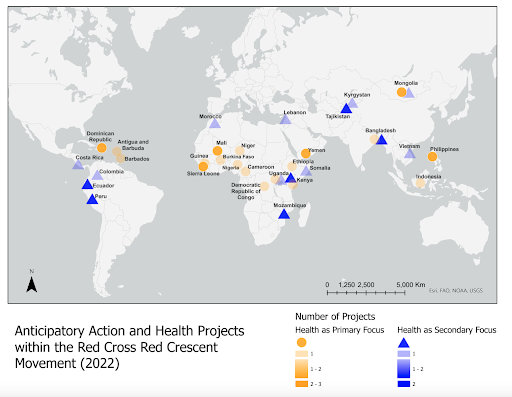Anticipatory action: what is the state of play for health-related applications in the Red Cross Red Crescent Movement?
Most anticipatory action initiatives have, to date, focused on extreme climate and weather events, for example the Early Action Protocol (EAP) for Cyclones in Bangladesh, the EAP for Cold Waves in Mongolia and the EAP for Floods in Kenya. But there is growing interest in the potential to act ahead of other types of hazard. This includes drivers of human suffering and loss such as infectious disease epidemics or major nutritional crises.
Early in 2021, the Anticipatory Action and Health working group was established to explore this growing field. It brings together staff from across the Red Cross Red Crescent Movement who work in disaster risk reduction, health, water, sanitation and hygiene (WASH), anticipatory action and related fields. One of the first questions the working group sought to tackle was: how is the Movement currently using anticipatory action initiatives and mechanisms for health interventions?

Anticipatory action for health interventions
An initial mapping exercise found 53 Red Cross Red Crescent health projects in 30 countries which are exploring, researching, piloting or have established anticipatory action approaches. However, it is important to note that this figure comes from a preliminary scan; the working group will continue to update this project list over time.
Of these, we identified 32 initiatives where health is the primary focus. This means that anticipatory action initiatives are being developed to directly forecast, anticipate and address health crises and their impacts. Currently, the majority of these focus on anticipating disease outbreaks, such as cholera, dengue and influenza.
In fact, there are various initiatives being developed to see how anticipatory action could stop a cholera outbreak from becoming a crisis. A draft anticipatory action protocol for cholera is being developed for global use across countries where cholera is endemic. This protocol, which will include suggested triggers and related actions, could be used as a model for other epidemic-prone diseases.
Other projects seek to replicate the methodology from the IBF dengue portal to other countries, and potentially to other mosquito-borne diseases (e.g., malaria). The IBF dengue portal was launched in 2021 in the Philippines and helps predict, based on meteorological data, which areas are prone to outbreaks, with a lead time of three months. Predicting periods of heightened risk, when caseloads may exceed seasonal averages, helps local healthcare systems prepare and thus avoid being overwhelmed.
Anticipating the health impacts of climate- and weather-related hazards
As noted, the Red Cross Red Crescent Movement has extensive experience in developing EAPs for climate- and weather-related hazards such as floods and cyclones. But these hazards can lead to a suite of negative health outcomes. At least 21 EAPs for hydrometeorological hazards contain carefully chosen early actions that try to mitigate outbreaks or a deterioration in health conditions. For example, in Mozambique’s EAP for Cyclones, chlorine tablets and buckets are distributed as an early action to mitigate diarrheal diseases.
There are also non-hydrometeorological EAPs and these can also list health-related early actions. In Ecuador and Costa Rica, EAPs for volcanic eruptions include as early actions the provision of respiratory masks and eye protection in the locations likely to see the worst volcanic ash fall (this is assessed based on wind direction and speed).
The work continues
It is critically important to get ahead of health impacts, whether caused by hydrometeorological hazards, disease outbreaks or famine/lean seasons. Mapping existing health-related anticipatory action initiatives helps provide a snapshot of the current state of practice, while also advancing knowledge sharing internally. It should be noted that anticipatory actions are not intended to replace existing public health interventions, but instead aim to strengthen the timeliness and efficacy of actions, and mutually reinforce longer-term investments in risk reduction.
In another year marked by devastating global public health and climate crises, the Anticipatory Action and Health working group will help to catalyse further investment and progress in this field. Stay tuned to the latest developments here.
This blog was written by Flaam Hardy, a food system professional who is currently pursuing an MS in Agriculture, Food & Environment and MPH in Planetary Health at Tufts University, USA.

